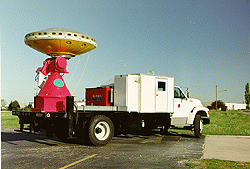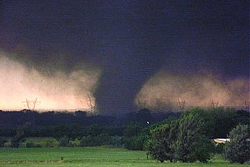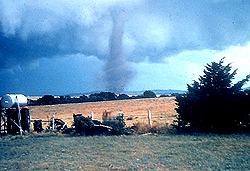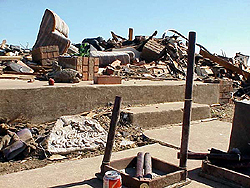| Tornadoes
are unpredictable, immensely powerful and can destroy anything that
lies in their path. In an interview with FirstScience, Josh Wurman,
Metereology Researcher at the University of Oklahoma explains his
fascination and his work with tornadoes.
FirstScience: When did your fascination with tornadoes
begin?
Josh Wurman: "I have been interested in the weather since
I was quite little. I used to cut out the daily weather maps from
the local newspapers and make weekly summaries for my elementary
school newspaper when I was just 7-9 years old. I like to understand
how things work, physics and mathematics, and nature. Meteorology
has let me combine my interests in a very interesting new field,
which has many important outstanding questions. I became interested
in tornadoes when I moved west to Colorado from Massachusetts several
years ago. I went chasing with scientist friends. I was amazed by
the structure, beauty and power of these storms. I wanted to understand
more about how they form and what was going on inside them. So I
designed new technology, the Doppler On Wheels radars, in the center
of tornado alley and began the serious pursuit of tornadoes."
FS: How do you find tornadoes and how do you chase them?
JW: "We forecast the general area in which tornadoes are likely
to form. Then we drive in this region and wait for storms to form.
When they do, we target the most interesting thunderstorms, watching
for any clues that it may be strengthening or weakening, and try
to place our radars near the region where the tornadoes form."
FS: What has been your scariest moment chasing a tornado?

Josh
Wurman
The
Doppler on Wheels measures the strength of a tornado
|
JW: "This may sound boring, but we really do not have many
scary moments. We are engaged in an intense scientific mission to
try to understand one of the most powerful forces of nature. But
we cannot afford to be thrill seekers, or to take unreasonable risks.
With an on-board Doppler radar, we can see the precise strength,
size and motion of a tornado. So even when we are very close to
one, at a range that might be frightening to those without all our
information and training, we are mainly focused on the mission,
where to go next, routes for targeting and escape etc. We are surprisingly
un-excited during intercepts."
FS: What is the most powerful tornado on record?
JW: "Unfortunately, very few tornadoes have had quantitative
measurements of their windspeeds. The highest windspeeds ever measured
were about 135 m/s in the tornado that went through Oklahoma City
on 3 May 1999.

NOAA
Fury
on the plains - the tornado that struck Oklahoma City in 1999
|
But it is very unlikely that this was the strongest tornado ever.
It just happened to be measured by us. These were measured with
the Doppler on Wheels radars. The traditional fashion in which tornadoes
are categorized is the Fujita scale. But, this only measures the
intensity of damage that the tornadoes have actually caused. A very
powerful tornado passing over open country (and 99% of the country
that tornadoes cover is open country, particularly in the sparsely
populated tornado alley) will only cause F0 damage but a weaker
tornado passing through a town might cause F4 damage. The Fujita
scale does not measure windspeeds. It is often misused by the media
and public. We propose that a Potential Fujita scale, similar to
the Saffir-Simpson scale used for hurricanes be adopted. The PF
scale will represent our best estimate of the actual windspeeds
in a tornado, and its potential for doing damage."
FS: How do tornadoes form?

NOAA
Tornado
alley in springtime - the Midwest USA is the most tornado
prone place in the world
|
JW: "The glib answer to that is we do not know. That is why
we are studying them. We know the basic processes by which rotation
is generated in supercellular thunderstorms. But we do not understand
how and why and when these rotations, called mesocyclones, produce
more intense, smaller-scale rotations called tornadoes. We do not
know how to predict when a particular supercell will produce a tornado.
We cannot forecast the size, strength, or lifetime of a tornado.
In short, even though major strides have been made in the understanding
of tornadoes and tornadogenesis in recent years, we have a long
way to go."
FS: Why do
tornadoes appear more regularly at certain times of the year and
why in only certain parts of the world?
JW: "The
most prolific tornado-producing region is the USA Midwest in the
springtime. It is all because of geography. The combination of a
source of warm moist air from the Gulf of Mexico, strong winds in
the upper mid-latitude troposphere, and warm mid-level air due to
solar heating of the high terrain to the west, near the rocky Mountains,
combine to make thunderstorms, rotating thunderstorms, an explosive
release of pent up energy possible."
FS: How many lives do you estimate have been lost to tornadoes
and what can be done to give people more advanced warnings?

NOAA
Tornadoes
are capable of lifting heavy trucks hundreds of feet into
the air
|
JW: "Tornadoes kill fewer people than some other weather phenomena.
Tornado deaths have been steadily dropping in recent decades due
to better warnings and public awareness. This is despite the increasing
population in the tornado-prone regions. I do not know the exact
numbers, but I think that less than 100 people are killed every
year, on average by tornadoes in the USA. Better warnings will require
a better understanding of the tornadogenesis process. We need to
know how, why and when tornadoes will form in particular storms.
More importantly we need to be able to distinguish between the very
rare powerful, long track, large tornadoes and the 90% that are
far weaker and pose less significant threats. 90% of tornadoes are
relatively minor, capable of removing or damaging buildings, but
not of the catastrophic damage caused by the few tornadoes that
contain winds in excess of 100 m/s. We also need better observations.
We propose that a network of adaptable observing systems, like the
Doppler On Wheels, be available to provide quick-update, high resolution
data to forecasters and computer forecast models so that better
predictions can be made. In the coming decade we hope that computer
models, based on better understanding and better observations will
be developed that will enable predictions of tornadoes an hour or
two in advance."
FS: What have you learnt from your research into tornadoes?

NOAA
The
aftermath of a tornado
- but trying to stop one could cause chaos somewhere else
in the world
|
JW: "We have learnt about the structure of tornadoes, including
3D windfield, how strong tornado winds actually are, confirmed the
existence of multiple-vortices circling around some tornadoes causing
extremely high winds near the surface. We are still trying to answer
the major questions about the birth of tornadoes, called tornadogenesis".
FS: Will we ever be able to control or stop tornadoes?
JW: "No. It is, of course, possible to stop a tornado. One
could drop a nuclear bomb and the heat of the explosion would disrupt
the tornado and even the parent thunderstorm. But, even if it were
practical to control or stop tornadoes, I believe it would be unwise
and immoral to do so. The mathematical and physical equations that
govern the atmosphere tell us that altering the weather in one area
at one time will cause unpredictable consequences elsewhere at later
times. it is morally wrong to purposely alter weather when the consequences
may negatively impact other people and regions in unpredictable
ways. No one can say whether preventing some tornadoes in Oklahoma
will make floods worse in India, or deprive Missouri farmers of
needed rain."
Copyright (c) FirstScience.com
|
